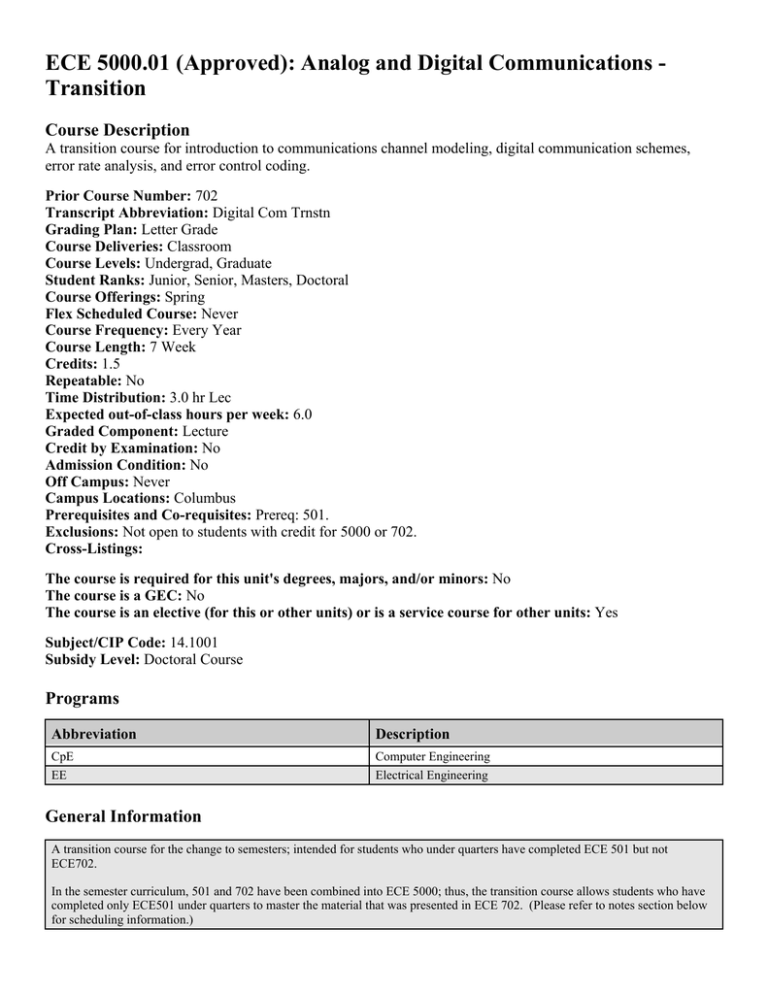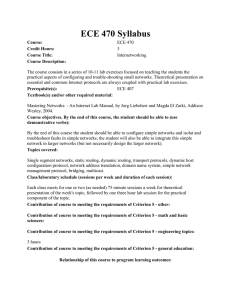ECE 5000.01 (Approved): Analog and Digital Communications
advertisement

ECE 5000.01 (Approved): Analog and Digital Communications Transition Course Description A transition course for introduction to communications channel modeling, digital communication schemes, error rate analysis, and error control coding. Prior Course Number: 702 Transcript Abbreviation: Digital Com Trnstn Grading Plan: Letter Grade Course Deliveries: Classroom Course Levels: Undergrad, Graduate Student Ranks: Junior, Senior, Masters, Doctoral Course Offerings: Spring Flex Scheduled Course: Never Course Frequency: Every Year Course Length: 7 Week Credits: 1.5 Repeatable: No Time Distribution: 3.0 hr Lec Expected out-of-class hours per week: 6.0 Graded Component: Lecture Credit by Examination: No Admission Condition: No Off Campus: Never Campus Locations: Columbus Prerequisites and Co-requisites: Prereq: 501. Exclusions: Not open to students with credit for 5000 or 702. Cross-Listings: The course is required for this unit's degrees, majors, and/or minors: No The course is a GEC: No The course is an elective (for this or other units) or is a service course for other units: Yes Subject/CIP Code: 14.1001 Subsidy Level: Doctoral Course Programs Abbreviation Description CpE Computer Engineering EE Electrical Engineering General Information A transition course for the change to semesters; intended for students who under quarters have completed ECE 501 but not ECE702. In the semester curriculum, 501 and 702 have been combined into ECE 5000; thus, the transition course allows students who have completed only ECE501 under quarters to master the material that was presented in ECE 702. (Please refer to notes section below for scheduling information.) Course Goals Learn introductory concepts about random signals and noise (e.g., power spectrum, autocorrelation, filtering of a random signal) Learn fundamental concepts in pulse-shaped digital communications (e.g., pulse shaping, matched filtering, raised-cosine pulses, Nyquist criterion) Learn fundamental concepts in error analysis of uncoded digital communications (e.g., eye and constellation diagrams, decision regions, gray coding) Students learn introductory concepts about error control coding. Learn introductory concepts about parallel digital communication schemes (e.g., CDMA and OFDM) and communication over dispersive channels (e.g., equalization) Learn to use Matlab for communication system simulation and analysis Course Topics Topic Lec DSP implementation of digital communications (sinc reconstruction, downsampling, discrete-time channel representation, fractional sampling) 2.0 Error analysis (eye diagram, constellation diagram, symbol alphabets, decision regions, symbol error rate, gray coding) 5.0 Error control coding 3.0 Parallel communication (generalizing the pulse shape, generalizing the matched filter, orthogonal pulse shapes like OFDM and CDMA, non-orthogonal pulse shapes, matched filtering) 6.0 Communication over dispersive channels (effective pulse shape, equalization, CP-OFDM) 3.0 Rec Lab Cli IS Sem FE Wor Representative Assignments Homework problems with both analytical and Matlab content will be assigned. Grades Aspect Percent Homework 20% One midterm exam 30% Final exam 50% Representative Textbooks and Other Course Materials Title Author Wireless Communications (online) Robert Heath, Jr. Instructor notes (online) Schniter ABET-EAC Criterion 3 Outcomes Course Contribution *** * ** ** College Outcome a An ability to apply knowledge of mathematics, science, and engineering. b An ability to design and conduct experiments, as well as to analyze and interpret data. c An ability to design a system, component, or process to meet desired needs. d An ability to function on multi-disciplinary teams. e An ability to identify, formulate, and solve engineering problems. f An understanding of professional and ethical responsibility. g An ability to communicate effectively. h The broad education necessary to understand the impact of engineering solutions in a global and societal context. i A recognition of the need for, and an ability to engage in life-long learning. j A knowledge of contemporary issues. k An ability to use the techniques, skills, and modern engineering tools necessary for engineering practice. CpE ABET-EAC Criterion 9 Program Criteria Outcomes Course Contribution Program Outcome * l Students have learned a range of technical topics comprising both breadth and depth. Students have learned circuits, systems and computer hardware and software sub-disciplines plus technical elective topics. * m Students can apply tools and knowledge, both technical and non-technical, obtained from their undergraduate experience to a major design project. ** n Graduates are aggressively recruited by both industry and graduate programs. EE ABET-EAC Criterion 9 Program Criteria Outcomes Course Contribution Program Outcome *** l Students have learned a range of technical topics comprising both breadth across circuits, systems, electromagnetics and electronic devices and depth in at least two sub-disciplines within electrical engineering. * m Students can apply tools and knowledge, both technical and non-technical, obtained from their undergraduate experience to a major design project. *** n Graduates are aggressively recruited by both industry and graduate programs. Additional Notes or Comments Scheduling: ECE 5000.01 will meet concurrently with ECE 5000 during the second term of the semester; thus, during the second term, the two courses -- 5000 and 5000.01 -- will meet in the same room at the same time with the same instructor. Sunset: course should withdrawn after need for transitioning students to semesters has been met. Changedx prereqs and exclusions to match university format. Text updated 3/27/12 Prepared by: Betty Lise Anderson

